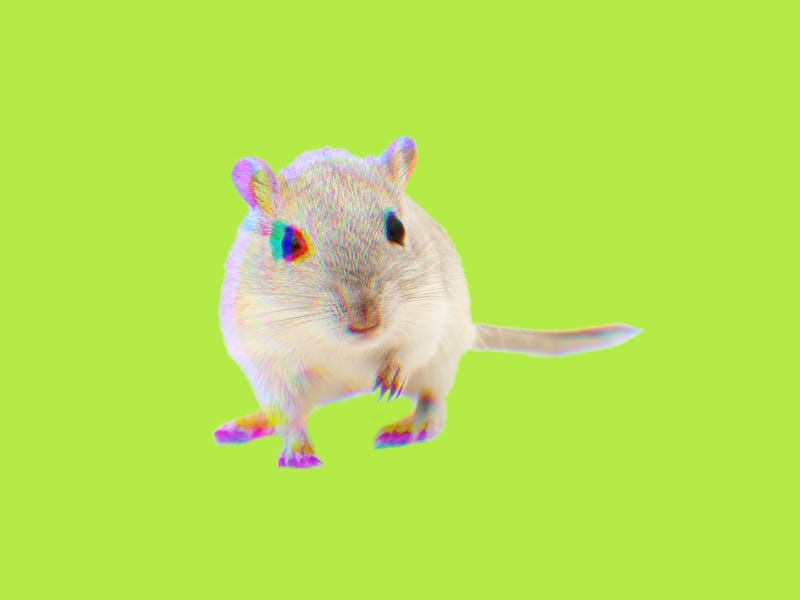Scientists Made Mice Hallucinate by Shining Holograms Onto Their Brains
The strange technique holds great therapeutic potential.

Hallucinations are often a confusing phenomenon in which the brain conjures images that aren’t really there. But there may be a way we could use them for good. Strange new research published Thursday in Science shows that it can be useful to shine light directly on the brains of mice to make them think they’re seeing something that isn’t really there.
The paper, which shows that mouse brains can be stimulated with light in a way that influences their visual systems, could help us develop neural prosthetics and treat psychiatric conditions that involve hallucinations or delusions. Since the authors basically induced hallucinations in the mice, it’s not a stretch to say that similar techniques could eliminate hallucinations that are happening in a human brain as a result of schizophrenia.
“More broadly, the ability to track and control large cellular-resolution ensembles over time during learning, and to selectively link new cells and ensembles together into behaviorally relevant circuitry, may have important implications for studying and leveraging plasticity underlying learning and memory in health and disease,” write the team, made up of scientists from Stanford University, Boulder Nonlinear Systems in Colorado, and the University of Tokyo.
The gene for the photoreceptive neurons came from Tiarina fusus, a marine microbe.
Making Mouse Brains Reactive to Light
This research starts with the principle of optogenetics, a relatively new field that involves splicing genes that encode light-reactive proteins into the brains of lab animals. When light is shone on these proteins in their brains, the cells respond in a desired way.
To create these conditions in the mice, the team scanned the genomes of more than 600 marine microorganisms for a gene that encoded a specific light-detecting protein. They found it in Tiarina fusus, an otherwise unspectacular algae. Then they spliced it into the mouse cells.
Using a virus to gain access to the mice’s DNA, they spliced the algae gene that encodes this protein into their visual cortices, making it so that the neurons in this portion of their brains would respond to light.
Now this is where the fun really begins.
Seeing Things That Aren’t There
The team wanted to use their optogenetic tools to manipulate how mice perceived visual information. But to start, they had to know what the animals were seeing in the first place.
The team first tracked how mice’s brains responded to two different visual patterns: black and white stripes that were either vertical or horizontal. recording which individual neurons were activated by the sensory perception. Different groups of mice were trained to lick when they saw one or the other.
Then, the authors used optogenetic stimulation to replicate the activation of these neurons. To do so, they shined near-infrared holograms directly onto the visual cortex of a mouse through a glass window implanted in the mouse’s skull.
When this happened, the mice responded by licking, the same behavior they’d been trained to perform when they saw the pattern. Only this time, the pattern wasn’t actually there.
Mice were rewarded or punished for licking a probe when the right visual signal was displayed (either horizontal or vertical stripes).
It’s not totally clear what the mice thought they were seeing, but based on their response to the light stimulation, it appears that they perceived it as the specific visual signal they’d been trained on — the stripes.
“Based on our experimental results, optogenetically-evoked percepts likely resembled corresponding visual percepts sufficiently to recruit the corresponding naturalistic visual-like neural dynamics and support robust and generalizable discrimination behavior,” they write.
Something that’s new about this study is that while in the past it was possible to influence the behavior of brain cells using light, it wasn’t possible to measure the effects this stimulation had on the animal’s perception.
This research suggests that not only can we influence an animal’s perception, but it can be done with great precision, down to just a few specific neurons.
Advocates of human brain hacking say that optogenetics could allow humans to enhance their central nervous systems by essentially creating new systems of neurotransmitters in their own brains that don’t interact with other existing systems. Since altered genes would require light to be activated, the chances (theoretically) would be low that they’d misfire.
A potential application for these new systems would be shining light on anxiety-involved neurons to help reduce anxiety. For now it’s just a dream, but this mouse study brings it a step closer to reality.
Abstract: Perceptual experiences may arise from neuronal activity patterns in mammalian neocortex. We probed mouse neocortex during visual discrimination using a red-shifted channelrhodopsin (ChRmine, discovered through structure-guided genome mining) alongside multiplexed multiphoton-holography (MultiSLM), achieving control of individually-specified neurons spanning large cortical volumes with millisecond precision. Stimulating a critical number of stimulus-orientation-selective neurons drove widespread recruitment of functionally-related neurons, a process enhanced by (but not requiring) orientation- discrimination task learning. Optogenetic targeting of orientation-selective ensembles elicited correct behavioral discrimination. Cortical layer specific-dynamics were apparent, as emergent neuronal activity asymmetrically propagated from layer-2/3 to layer-5, and smaller layer-5 ensembles were as effective as larger layer-2/3 ensembles in eliciting orientation discrimination behavior. Population dynamics emerging after optogenetic stimulation both correctly predicted behavior and resembled natural neural representations of visual stimuli.